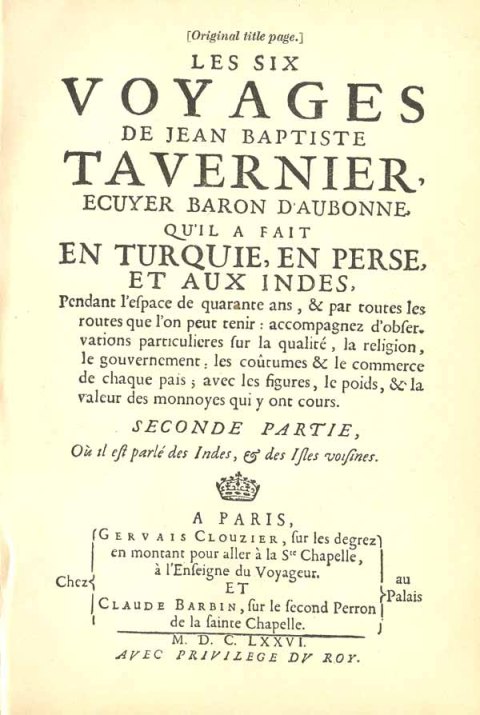AM | @HDI1780
"This whole chapter of Bernier deserves every Man's reading" — Cato's Letters
As readers of this blog know, I am a great fan of François Bernier (1625-1688). Voyages de François Bernier. Contenant la Description des Etats du Grand Mogol de l'Hindoustan, du Royaume de Cachemire, &c (Amsterdam, 1699) is a key source of top-Enlightenment thinkers like Montesquieu, Raynal-Diderot, Adam Smith and Volney. Voltaire and David Hume were also familiar with his works [1]. As for Karl Marx, he used to spend hours reading Bernier in the British Museum, enjoying every line of the Voyages [2].
"This whole chapter of Bernier deserves every Man's reading" — Cato's Letters
As readers of this blog know, I am a great fan of François Bernier (1625-1688). Voyages de François Bernier. Contenant la Description des Etats du Grand Mogol de l'Hindoustan, du Royaume de Cachemire, &c (Amsterdam, 1699) is a key source of top-Enlightenment thinkers like Montesquieu, Raynal-Diderot, Adam Smith and Volney. Voltaire and David Hume were also familiar with his works [1]. As for Karl Marx, he used to spend hours reading Bernier in the British Museum, enjoying every line of the Voyages [2].
I plan to transcribe Bernier's fantastic "Lettre à Monseigneur Colbert sur l'Hindoustan" in its entirety for the enjoyment of readers of this blog. And there will be further posts on his ideas. But there was another notorious contemporary traveller, Jean-Baptiste Tavernier (1605-1689), a gem merchant who was sometimes mistaken for Bernier [3]. This is apparent in Vol. II of the 1723 edition of Cato's Letters, which mentions "the great and judicious traveller Monsieur Tavernier" (p. 143). But it was Bernier, not Tavernier! The mistake was corrected in the 1755 edition.
* * *
When Tavernier, a jeweller, visited the diamond mines of Golconda and Visiapour, he was informed that the sovereign of the country, for whose benefit they were wrought, had ordered all of them to be shut up, except those which yield the largest and finest stones. The others, it seems, were to the proprietor not worth the working.
In his short entry "Sur le Tien et le Mien" —Bernier's most famous phrase, which shows up in Book XI of Histoire des deux Indes—, Antoine-Angélique Chomel acknowledges the two authors/travellers. He argues that they shared a similar worldview. Shaken by the appalling mix of despotism and poverty that they saw in the East, both men strongly argued for moderate government and for the protection of property rights:
Le fameux Tavernier ayant vendu les pierreries qu'il avoit apporté des Indes, témoigna devant le Roi qu'il avoit dessein d'acheter une Seigneurerie en Suisse; & ce prince lui ayant demandé d'où venoit qu'il n'en achetoit point une dans son Royaume, Tavernier qui n'avoit aucune politesse répondit: c'est que je veux que ma Seigneurerie soit à moi [4].
____
[1] Hume read Bernier's article "Nouvelle Division de la Terre", published anonymously in Journal des sçavans in 1684 [see].
[2] Karl Marx to Friedrich Engels, 6 June 1853: "Die Sachen von alten Bernier sind wirklich sehr schön. Man freut sich ordentlich einmal wieder etwas von einem alten nüchternen, klaren Franzosen zu lesen der überall den Nagel auf dem Kopf trifft sans avoir l'air de s'en apercevoir". Marx Engels Gesaumtausgabe. Briefwechsel September 1852 bis August 1853. Berlin: Dietz Verlag, 1987 [voir].
[3] Jean-Baptiste Tavernier. Les Six Voyages de Jean-Baptiste Tavernier en Turquie, en Perse et aux Indes. Paris : Gervais Clouzier, 1676.
[4] Antoine-Angélique Chomel. Les Nuits parisiennes à l'imitation des Nuits attiques d'Aulu-Gelle, I. Paris : Lacombe, 1769, pp. 90-91.
In his short entry "Sur le Tien et le Mien" —Bernier's most famous phrase, which shows up in Book XI of Histoire des deux Indes—, Antoine-Angélique Chomel acknowledges the two authors/travellers. He argues that they shared a similar worldview. Shaken by the appalling mix of despotism and poverty that they saw in the East, both men strongly argued for moderate government and for the protection of property rights:
Le fameux Tavernier ayant vendu les pierreries qu'il avoit apporté des Indes, témoigna devant le Roi qu'il avoit dessein d'acheter une Seigneurerie en Suisse; & ce prince lui ayant demandé d'où venoit qu'il n'en achetoit point une dans son Royaume, Tavernier qui n'avoit aucune politesse répondit: c'est que je veux que ma Seigneurerie soit à moi [4].
____
[1] Hume read Bernier's article "Nouvelle Division de la Terre", published anonymously in Journal des sçavans in 1684 [see].
[2] Karl Marx to Friedrich Engels, 6 June 1853: "Die Sachen von alten Bernier sind wirklich sehr schön. Man freut sich ordentlich einmal wieder etwas von einem alten nüchternen, klaren Franzosen zu lesen der überall den Nagel auf dem Kopf trifft sans avoir l'air de s'en apercevoir". Marx Engels Gesaumtausgabe. Briefwechsel September 1852 bis August 1853. Berlin: Dietz Verlag, 1987 [voir].
[3] Jean-Baptiste Tavernier. Les Six Voyages de Jean-Baptiste Tavernier en Turquie, en Perse et aux Indes. Paris : Gervais Clouzier, 1676.
[4] Antoine-Angélique Chomel. Les Nuits parisiennes à l'imitation des Nuits attiques d'Aulu-Gelle, I. Paris : Lacombe, 1769, pp. 90-91.
____________________________

No comments:
Post a Comment